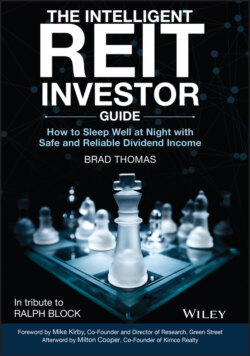Читать книгу The Intelligent REIT Investor Guide - Brad Thomas - Страница 20
Bonds
ОглавлениеBonds, particularly so‐called junk bonds, usually provide higher yields than the average REIT. But the investor gets only the interest coupon and no growth potential. That's because they're so safe, promising repayment of principal at maturity. In the absence of bankruptcy or some other kind of default, bond investors always get their money back.
The same cannot be said about REITs.
With bonds, what you see is what you get: pure yield and very little else. Take a $10,000 investment in a bond that yields 5% and matures in 10 years. At the end of that decade, you'll have your $10,000 in cash, plus the cumulative amount of interest received (10 × $500) for a total of $15,000.
Now let's say you purchase 1,000 shares of a REIT trading at $10 that offers a 4% yield ($0.40 per share). It also increases its adjusted funds from operations (AFFO) – which, as we'll discuss in more detail later, is a rough approximation of FCF – by 4% annually and its dividend the same amount. The shares then rise in price 4% as well.
Ten years later, the REIT will be paying $0.593 in dividends, and the total investment will be worth $19,812: $4,992 in cumulative dividends received plus $14,820 in share value at that time. That's a difference of $4,812 between the two asset examples, as shown in Table 2.1.
Taxes, of course, will have to be paid on both, cutting into profits on either side. And conventional wisdom says that REITs should provide a higher total return in the end since they're riskier than bonds. However, that's not necessarily true if we consider the bond owner's exposure to inflation. REIT shares offer no specific maturity date, and there's no guarantee of the price you'll get when you sell them. However, bonds have no inflation protection. Their holders are at substantial risk of seeing their purchasing power decline with the dollar.
It's all a question of how one measures risk.
Also, when inflation rises, interest rates historically tend to do the same. This reduces bonds’ market values while they're being held, to the further detriment of anyone who needs to sell them prior to maturity. On the flipside, if interest rates decline enough due to, say, lower inflation, many bonds may be called for redemption before their maturity dates. This deprives investors of what could have otherwise been very attractive yields and forces them to go out hunting again.
Table 2.1 REITs Should Produce Better Total Returns than Bonds
| REITs: 4% annual dividend compounded at a 4% annual growth rate | ||
|---|---|---|
| End Year | Stock Price | Per‐Share Dividend |
| 1 | $10.40 | $0.400 |
| 2 | $10.82 | $0.443 |
| 3 | $11.25 | $0.450 |
| 4 | $11.70 | $0.468 |
| 5 | $12.17 | $0.487 |
| 6 | $12.66 | $0.506 |
| 7 | $13.17 | $0.527 |
| 8 | $13.70 | $0.548 |
| 9 | $14.25 | $0.570 |
| 10 | $14.82 | $0.593 |
| $4,992 | ||
| 1,000 shares | $14,820 | $4,992 |
| Total Investment value | $19,812 |
Source: Investing in REITs by Ralph Block.
Admittedly, a REIT's stock price may decline in response to higher interest rates. But interest rates often climb alongside a growing economy, which helps to grow REIT cash flows over time.
For those who want to point out U.S. Treasury bonds as a solution, yes, those aren't callable prior to maturity. And, yes, they entail no repayment risk. But their yields are lower than those of corporate bonds, and they still fluctuate with interest rates regardless.
Bonds are certainly suitable investments for most investors. However, they shouldn't be regarded as good substitutes for REIT stocks in a broadly diversified portfolio. Nor should REIT stocks be seen as good substitutes for bonds.
